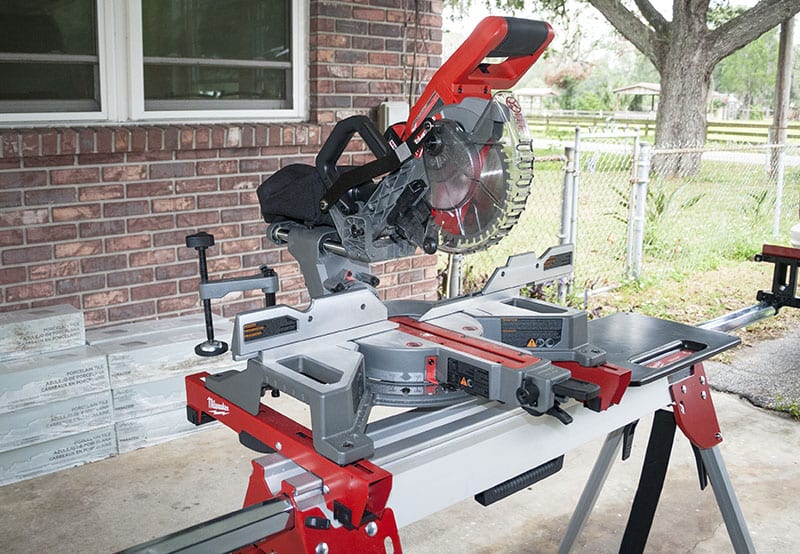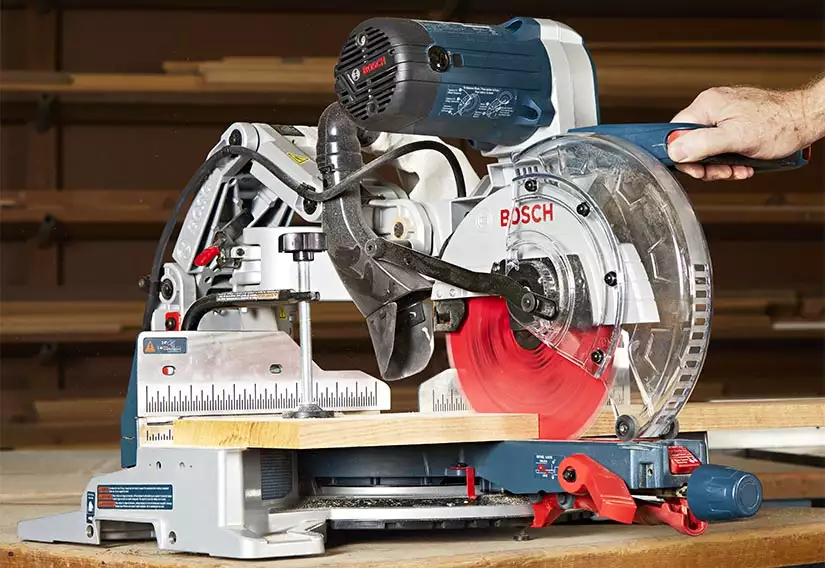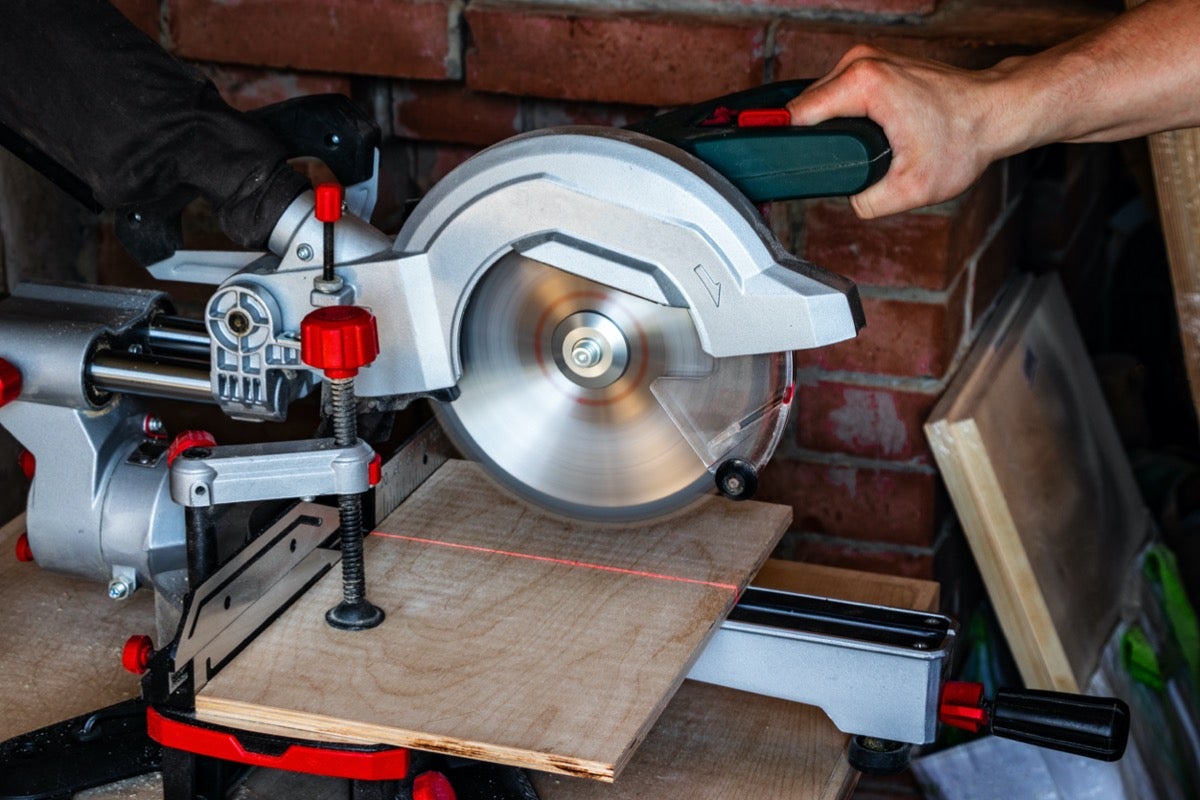When it comes to carpentry and Do-It-Yourself projects, having the right tools can make all the difference. Two commonly used tools in the carpenter’s arsenal are the miter saw and the compound miter saw. These two saws are essential for making precise cuts at various angles but serve slightly different purposes.
This discussion will explore the topic (Miter Saw vs. Compound Miter Saw) and the key differences between them, highlighting when and why you might choose one over the other. So, let’s explore the world of miter saws vs. compound miter saws and discover which suits your needs best.
Understanding Miter Saws
Key Components
- Circular Blade: Miter saws feature a circular blade with teeth designed for cutting wood, plastic, or, in some cases, metal. Blade sizes typically range from 8 to 12 inches or more.
- Blade Guard: A blade guard is a safety feature that covers the blade when it’s not in use. It automatically lifts during cutting and returns to its protective position when completed.
- Miter Scale: The miter scale is a protractor-like feature that allows you to set the saw’s base at various angles, making miter cuts across the width of the material. Standard angles include 45 degrees for corner joints.
- Bevel Adjustment: Many miter saws have a bevel adjustment that tilts the blade to the left or right. This allows you to make bevel cuts, angling the blade through the thickness of the material.
- Fence: The fence is a vertical surface that provides stability and guidance for the workpiece during cutting, ensuring accuracy.
- Work Clamp: Some miter saws come with a work clamp or vise-like jaws to hold the workpiece securely in place while cutting.
Types of Miter Saws
- Basic Miter Saw: These models allow for miter cuts only, making them suitable for tasks like cutting trim and framing components.
- Compound Miter Saw: Compound miter saws can create miter and bevel cuts, offering greater versatility for tasks like crown molding and beveled trim.
- Sliding Compound Miter Saw: These can perform miter, bevel, and sliding crosscuts, making them ideal for handling wider workpieces.
Common Uses
- Trim Carpentry: Miter saws are frequently used in trim carpentry for cutting baseboards, crown molding, and trim pieces with precise angles.
- Framing: They create angled cuts for framing components, especially for framing corners.
- Cabinet Making: Miter saws are essential for cutting cabinet parts, including frames and door components.
- Home Improvement: They are handy for various home improvement projects that require precise cuts in wood, plastic, or other materials.
Understanding Compound Miter Saws
Key Components
- Circular Blade: Like other miter saws, a compound miter saw is equipped with a circular saw blade designed for cutting wood, plastic, or, in some cases, metal. Blade sizes vary, with 10-inch and 12-inch blades being standard.
- Blade Guard: A blade guard is a safety feature that covers the blade when it’s not in use and retracts during cutting. It helps prevent contact with the blade.
- Miter Scale: The miter scale is a protractor-like feature that allows you to set the saw’s base at various angles, making miter cuts across the width of the material. Standard angles include 45 degrees for corner joints.
- Bevel Adjustment: Compound miter saws have a bevel adjustment that tilts the blade to the left or right. This allows you to make bevel cuts, angling the blade through the thickness of the material.
- Fence: The fence is a vertical surface that provides stability and guidance for the workpiece during cutting, ensuring accuracy.
- Work Clamp: Some compound miter saws come with a work clamp or vise-like jaws to hold the workpiece securely in place while cutting.
Types of Compound Miter Saws
- Single Bevel Compound Miter Saw: This can tilt the blade in one direction (usually to the left) for bevel cuts. It would help if you flipped the workpiece to make slant cuts the other way.
- Double Bevel Compound Miter Saw: These miter saws can tilt the blade in both directions without flipping the workpiece. This feature adds convenience, especially when making complex compound cuts.
Common Uses
- Crown Molding: Compound miter saws are commonly used to cut crown molding, often involving miter and bevel cuts.
- Framing: They are valuable for framing projects, allowing you to make angled cuts for framing components, such as roof rafters.
- Trim Carpentry: Compound miter saws are indispensable for cutting baseboards, chair rails, and trim pieces with precise angles and slopes.
- Cabinet Making: Cabinetmakers use these saws for cutting cabinet parts, including frames, shelves, and doors.
- Woodworking and DIY Projects: They are versatile tools for woodworking and DIY projects requiring angled or beveled cuts in wood or other materials.
Compound miter saws are valuable tools that offer enhanced cutting capabilities, making them versatile choices for professionals and DIY enthusiasts. They excel at making precise miter and bevel cuts, adding flexibility to a wide range of woodworking and construction projects. Understanding their features and safety considerations is crucial for safe and effective use.
Critical Differences Between Miter Saws and Compound Miter Saws
Miter and compound miter saws are powerful cutting tools used in woodworking and construction but differ in their capabilities and applications. Here are the key differences between these two types of saws:
Miter Saw
- Miter Cuts Only: A standard miter saw is designed primarily for making miter cuts, which are angled cuts across the width of a workpiece. It cannot make bevel cuts.
- Limited Bevel Capability: Basic miter saws have limited or no bevel capability. They can only make straight, vertical cuts.
- Angle Adjustability: Miter saws feature a miter scale that allows you to set the saw’s base at various angles to make miter cuts. Standard angles include 45 degrees for corner joints.
- Applications: Miter saws are commonly used for tasks like cutting trim, crown molding, baseboards, and other materials that require precise angled cuts across the width of the material.
- Simplicity: Standard miter saws are simpler in design and operation than compound miter saws, making them more user-friendly for basic miter-cutting needs.
Compound Miter Saw
- Miter and Bevel Cuts: A compound miter saw can make miter cuts (angled cuts across the width) and bevel cuts (angled cuts through the thickness). This makes it more versatile than a standard miter saw.
- Single Bevel or Double Bevel: Compound miter saws are available in single and double bevel.
- Single Bevel: These saws can tilt the blade in one direction (usually to the left) for bevel cuts. It would help if you flipped the workpiece to make bevel cuts.
- Double Bevel: Double bevel compound miter saws can shift the edge in the two bearings (left and correct)) without flipping the workpiece. This adds convenience when making complex compound cuts.

- Applications: Compound miter saws are suitable for a broader range of applications, including tasks that require both miter and bevel cuts, such as crown molding, framing, trim carpentry, and more.
- Complex Cuts: They are ideal for making complex compound cuts, where the miter and bevel angles are adjusted simultaneously, allowing for intricate woodworking and framing projects.
- Flexibility: Making bevel cuts without flipping the workpiece adds flexibility and convenience, especially when working with broad or long materials.
While standard miter saws are limited to making miter cuts, compound miter saws offer the additional capability of making bevel cuts, making them more versatile for a broader range of woodworking and construction tasks. The choice between the two depends on the complexity of your cutting needs and the versatility required for your projects.
Advantages and Disadvantages of Miter Saws
Miter saws are versatile power tools with several advantages but limitations. Understanding the upsides and downsides of utilizing a miter saw can help you make informed decisions when selecting a saw for your projects:
Advantages of Miter Saws
- Precise and Accurate Cuts: Miter saws excel at making precise and accurate cuts, whether straight crosscuts or angled miter cuts. This precision is crucial for tasks like trim carpentry and framing.
- Versatility: Depending on the type (primary, compound, or sliding compound), miter saws can handle various cutting tasks. They can make miter, bevel, and compound cuts, offering flexibility for various projects.
- Speed and Efficiency: Miter saws are known for their speed and efficiency in making repetitive cuts. This efficiency is particularly valuable for professionals and DIY enthusiasts who must complete projects quickly.
- Clean Cuts: Miter saws produce clean and splinter-free cuts, leaving a polished finish on wood and other materials.
- Ease of Use: Miter saws are relatively easy to use, even for beginners. They come with features like fences, workpiece clamps, and angle adjustments that enhance user-friendliness.
- Safety Features: Most miter saws have safety features such as blade guards, electric brakes, and trigger locks to help prevent accidents.
Disadvantages of Miter Saws
- Limited Cutting Width: Miter saws have a limited cutting width capacity, which may need to be improved for wide boards or oversized materials. In such cases, you may need to flip the material or use a sliding compound miter saw.
- Bulky and Stationary: Miter saws are relatively large and heavy, making them less portable than other power saws like circular saws.
- Limited to Straight Cuts: Basic miter saws are primarily designed for straight crosscuts and angled miter cuts. They cannot perform curved cuts or intricate shaping tasks.
- Expensive: High-quality miter saws, especially compound and sliding compound models, can be expensive. This cost may be a barrier for some users, especially hobbyists.
- Not Suitable for All Materials: While miter saws are excellent for wood and wood-based materials, there may be better choices for cutting specific materials like metals, concrete, or tile. Specialized saws are required for these materials.
- Dust Management: Miter saws generate significant sawdust, and effective dust management systems are often necessary to maintain a clean and safe workspace.
Miter saws are valuable tools for tasks that require precision and speed. However, they may have limitations regarding cutting width, versatility for different materials, and portability. Cautious thought of your venture needs and spending plan will help determine whether a miter saw is the right tool for you.
Advantages and Disadvantages of Compound Miter Saws
Compound miter saws are versatile power tools with several advantages but limitations. Understanding the upsides and downsides of utilizing a compound miter saw can help you decide whether it’s the right tool for your specific projects:
Advantages of Compound Miter Saws
- Miter and Bevel Cuts: The primary advantage of compound miter saws is their ability to make miter cuts (angled cuts across the width) and bevel cuts (angled cuts through the thickness). This versatility allows for more complex and intricate cuts.
- Versatility: Compound miter saws are suitable for many applications, including crown molding, trim carpentry, framing, and more. Their ability to handle both miter and bevel cuts makes them highly versatile.
- Time Efficiency: These saws are efficient for making angled and beveled cuts quickly and accurately. They save time, especially when working on projects that require a combination of different cuts.
- Precision and Accuracy: Like standard miter saws, compound miter saws are known for their precision and accuracy in making cuts. This is essential for achieving tight-fitting joints and clean, professional-looking work.
- Safety Features: Most compound miter saws have features such as blade guards, electric brakes, and trigger locks to enhance user safety during operation.
- Ease of Use: Compound miter saws are user-friendly and accessible to beginners and experienced woodworkers. They often include features like workpiece clamps and laser guides for added convenience.
Disadvantages of Compound Miter Saws
- Cost: Compound miter saws, exceptionally high-quality models, can be relatively expensive. This cost may be a budget consideration for hobbyists and DIY enthusiasts.
- Bulky and Heavy: Compound miter saws are generally larger and heavier than other power saws, making them less portable and harder to transport to job sites.
- Complexity: The ability to make both miter and bevel cuts adds complexity to the saw’s design. Users may need more time to learn how to use the tool effectively.
- Not Suitable for All Materials: While compound miter saws are excellent for wood and wood-based materials, there may be better choices for cutting specific materials like metals, concrete, or tile. Specialized saws are required for these materials.
- Dust Management: Compound miter saws produce significant sawdust, and effective dust management systems are often necessary to maintain a clean and safe workspace.

Compound miter saws are versatile and efficient tools for woodworking and construction projects that require precise miter and bevel cuts. While they come with a higher cost and are relatively heavy, their versatility and ability to handle complex cuts make them indispensable for professionals and enthusiasts seeking accuracy and flexibility.
Choosing the Right Tool for Your Project: Miter saw vs. compound miter saw
When deciding between a standard miter saw and a compound miter saw, it’s crucial to consider the nature of your project. If your work primarily involves basic crosscuts and straightforward miter angles, a standard miter saw can be cost-effective and user-friendly, making it reasonable for fledglings and those on a strict spending plan.
However, if your project involves complex cuts, compound angles, or the need for bevel cuts, a compound miter saw offers the versatility and precision required for such tasks. It becomes invaluable for projects like crown molding, intricate trim carpentry, or framing with compound angles.
Price Comparison between miter saw, and compound miter saw
Miter and compound miter saws have varying prices, mainly determined by brand, features, quality, and size factors. Basic miter saws, often with smaller blade sizes, can be affordable, from around $100 to $200.
These entry-level options are suitable for straightforward crosscuts and miter cuts. Moving up the price range, mid-range miter saws with larger blades (10 to 12 inches) and added features like bevel capability typically fall in the $200 to $500 range.
These saws offer versatility for a broader range of woodworking and construction tasks. For professionals and experienced users who demand precision and durability, high-end miter saws can go for $500 to $1,000 or more. These top-tier options excel in complex projects. Compound miter saws have similar price variations with their capacity to make miter and slope cuts.
Entry-level single-bevel models cost around $200 to $300, while mid-range and double-bevel compound miter saws can go from $300 to $1,000 or more. Keep in mind that specialized features can also affect pricing.
Choosing between a miter saw and a compound one depends on your specific project needs, budget, and the cutting versatility required.
Conclusion
The choice between a miter saw and a compound miter saw depends on the specific needs and preferences of the user. Both tools offer valuable features for woodworking and other tasks.
Ultimately, the decision should be based on the types of projects you plan to tackle and your skill level. Experienced woodworkers or those who frequently work on intricate projects may find the additional features of a compound miter saw invaluable.
A standard miter saw may satisfy beginners or those with more straightforward cutting needs. Regardless of the choice, safety precautions, proper maintenance, and familiarity with the chosen tool are essential for successful and safe woodworking endeavors.

